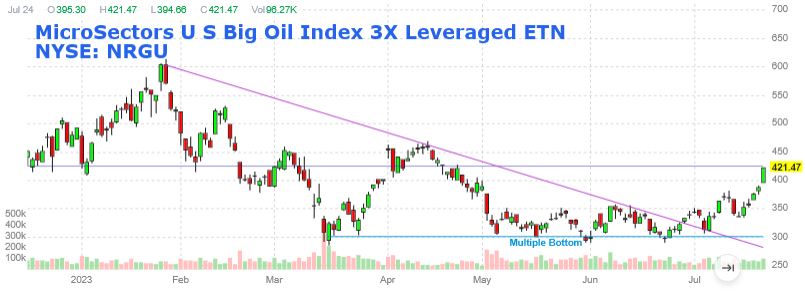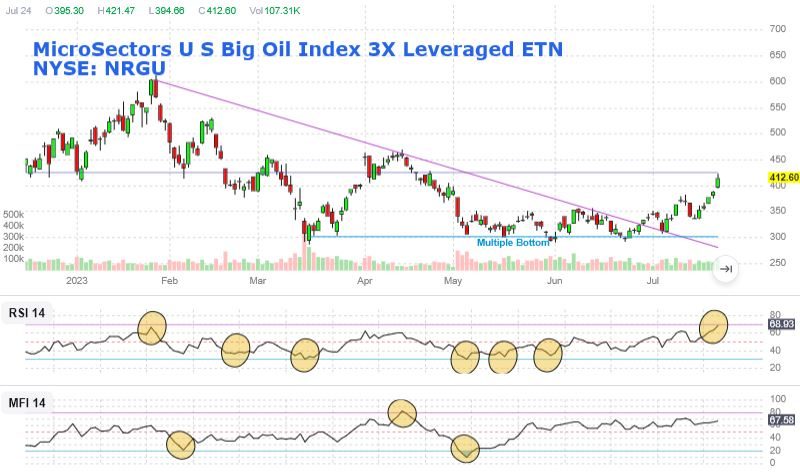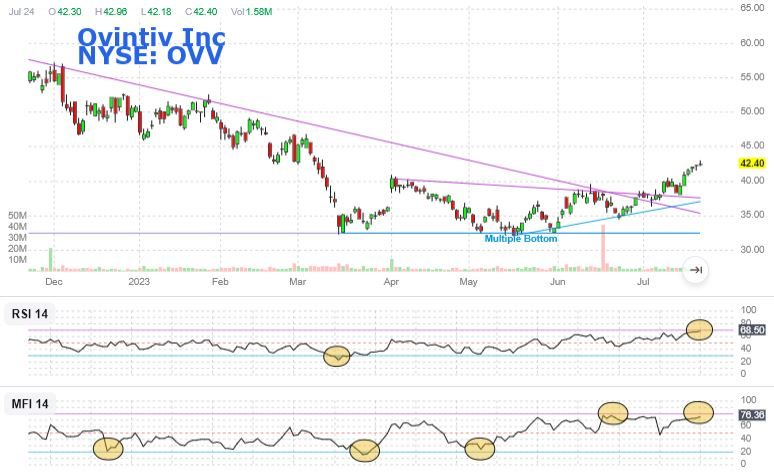"When's the best time to buy oil?" is the question that lands in my inbox more often than any other. And I get it. Timing the market can feel like trying to catch a falling knife, especially in a sector as volatile as energy.
As much as I love hearing from readers, clearly there's a need for folks to understand how to time the oil markets for themselves. This is the perfect opportunity to equip you with the tools and knowledge to make these calls yourself.
There's no better way to boost your profit potential in a critically important global market.
So today… I'm not going to tell you when to buy oil. Instead, I'm going to show you a secret that'll help you answer that question yourself, any time you want.
Ready for it? It's the MicroSectors U.S. Big Oil Index 3X Leveraged ETNs, or NRGU for short.
Think of it as "the Matrix" for the oil markets. It's not an exchange-traded fund (ETF); it's an exchange-traded note or… ETN. An ETN is a type of unsecured debt security that tracks an index of securities and trades on a major exchange. A triple-leveraged ETN is designed to move three times as much as the index it tracks. In the case of NRGU, it offers triple-leveraged exposure to the underlying performance of the Solactive MicroSectors U.S. Big Oil Index.

"The what," you ask.
The Solactive MicroSectors U.S. Big Oil Index measures the performance of the largest ten oil and gas companies. We're talking Exxon Mobil Corporation (XOM), Chevron Corporation (CVX), ConocoPhillips (COP), Schlumberger Limited (SLB), Pioneer Natural Resources Company (PXD), EOG Resources, Inc. (EOG), Phillips 66 (PSX), Occidental Petroleum Corporation (OXY), Valero Energy Corporation (VLO), and Marathon Petroleum Corporation (MPC).
This gives me a 30,000-foot view of the entire energy sector. Now, get this: If you watch the Relative Strength Index (RSI) and the Money Flow Index (MFI) of the NRGU, you can get a clear view of the defined range for oil. This is because institutional investors often take profits and cover their short positions when we approach oversold or overbought conditions. Specifically, when the RSI dips below 30, it's an optimal time to sell bull put spreads or even consider purchasing call options.

Now, I can almost hear you asking, "Garrett, that's all well and good, but when should I buy this thing?"
The answer is never. Don’t buy NGRU. Don’t go near it with a 10-foot pole; it’s triple-leveraged, and if you’re not watching your screen like a hawk at all hours, you can easily get wiped out owning or trading this.
NGRU is purely a tool to use; it’s there for us to watch, nothing more. It really is the best way to tell when to enter and exit positions in the oil patch. And as you can see from the chart, the RSI indicates we’re in overbought territory.
I like Ovintiv (OVV) as a way to capitalize on this. Sharp-eyed readers will recognize it as one of our Permian Basin stocks.
Ovintiv is a major player in both the oil and natural gas sectors. This dual focus gives it a unique position in the energy market, allowing it to capitalize on opportunities in both segments.
The company’s fundamentals are robust. It's currently undervalued, trading at around 80 cents on the dollar for its book value, which not-so-subtly suggests significant upside potential. The company's Piotroski F-score, a measure of financial health and stability, is under 0.5, indicating a strong financial position. Furthermore, Ovintiv boasts impressive margins of 62%, demonstrating its efficiency in converting sales into profits.

Oil looks overbought, as you can see by the RSI in the chart above, so don't be surprised if, in the short term, we see a sell-off and energy pulls back. This is how these markets have been operating for the last year and a half. Energy takes a nosedive because funds decide to take their profits and run the moment they sense anything awry with the broader market.
We learned this the hard way in the June sell-off last year. We haven't been back to those oversold levels since May. But if we do get back down there, that's your moment to strike. When you find yourself in oversold territory, that's your cue to make a move on Ovintiv.

Oil prices are rising, but this rally could be getting a bit long in the tooth as the RSI and MFI approach overbought levels of 70 on the NRGU, typically signaling a time to start heading in the opposite direction.
This week we could see some profit-taking following a significant move for oil and companies like Ovintiv. We've seen this happen multiple times - big moves in a value stock. There's a cycle in which there's some profit-taking, then fund managers watching key technical levels step back in when the pot is sweet and buy the stock again.
There's really no roadblocks slowing down energy at the moment because there's a whirlwind of speculation swirling around OPEC cuts, Russia, and the chatter about lower supply and increased demand for the second half of the year. All this is taking place against a backdrop of expanded liquidity, which is bullish for commodities.

So, if we see a round of selling this week, look down around the $35/$33 support level to sell put spreads, or if you're looking to generate income and you're happy to take delivery of the stock, look out several months and sell the $33 put.
And if you're still on the fence about Ovintiv, here's something that might tip the scales: Michael "Big Short" Burry's Scion Asset Management is a significant buyer of OVV stock.

So, there's a lot of opportunity here. Just keep an eye on the NRGU; when it gets oversold, you can be confident taking a shot for the long term.
Cheers,
 Garrett Baldwin
Garrett Baldwin
Florida Republic Capital
About the Author
Garrett Baldwin is a globally recognized research economist, financial writer, consultant, and political risk analyst with decades of trading experience and degrees in economics, cybersecurity, and business from Johns Hopkins, Purdue, Indiana University, and Northwestern.



